Category: Bali Green Stone
Bali Green Stone is our advanced natural stone tile for swimming pool purposes. This exotic green and durable natural stone consist of zeolite chemical that can bring the stone to become a healthy pool solution. Explore our high-quality and exotic green sukabumi stone to brings the beauty of Bali nature into your pool!
During our recent visit to Switzerland, we encountered a swimming pool in a villa nestled among the majestic Alps that captivated us instantly. This pool was lined with Bali Green Stone, an authentic natural stone from Indonesia that brings a distinctive tropical touch. Amid the crisp Swiss landscape, the turquoise green hue of the stone created the illusion of an elegant tropical oasis, infusing a sense of Bali’s warmth and freshness into the cool mountain air.
Visual and Functional Advantages of Bali Green Stone
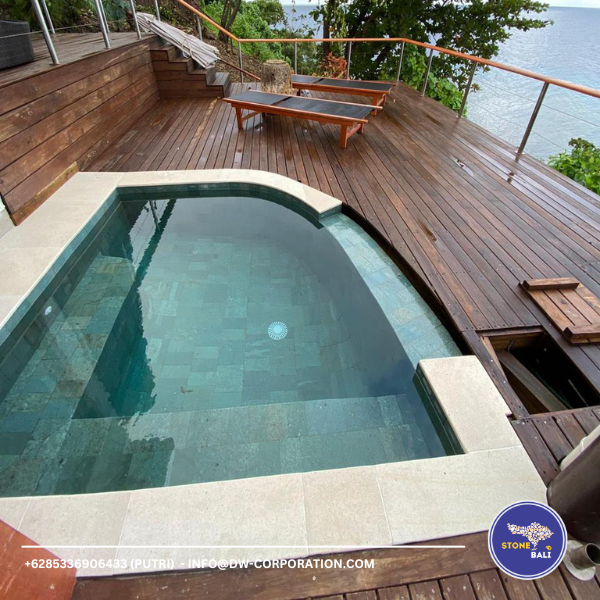
The main allure of Bali Green Stone is its ability to transform pool water into a naturally vibrant bluish-green, reminiscent of tropical beaches. This is not a sight often seen in Switzerland, making it a unique statement for pools here. When we touched the smooth, cool surface of the stone beneath the feet, immediately we understood why this stone is favored by luxury resorts worldwide.
Beyond its striking aesthetics, the stone also excels in functionality. We found the pool water warmer and more comfortable, thanks to the stone’s natural heat-absorbing and retaining qualities. This is especially beneficial in Switzerland’s often cool climate—the stone’s resilience to extreme temperature changes ensures that the pool remains beautiful and comfortable year-round.
Bali Green Stone: A Durable Material that Elevates Aesthetic Value
Bali Green Stone is known not only for its beauty but also for its durability. This Bali natural stone withstands a range of weather conditions, from intense heat to low temperatures. This is especially valuable in Switzerland, where the climate can shift drastically between seasons. The stone maintains its elegance even when exposed to constant water and direct sunlight. For property owners in Switzerland, it provides both resilience and a refined look.
We also felt that a pool lined with Pedra Hijau Verde has a unique appeal that’s hard to find in pools made with other materials. The natural stone surface and its rich color blend seamlessly with the water, creating a relaxing and soothing atmosphere. This tropical impression brings a different energy to the European landscape, as if Bali were right there in the heart of Switzerland.
Personal Experience: Blending with a Tropical Vibe Amidst Swiss Scenery
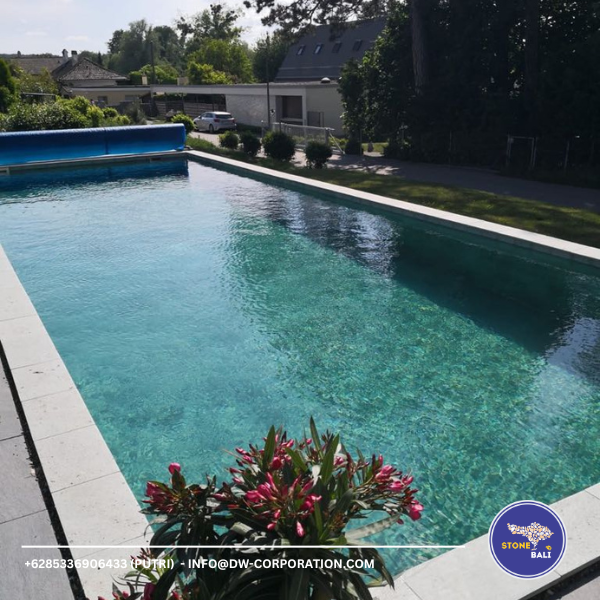
For several days, we spent time in that pool, and each time we dipped our feet in, it felt like we were transported back to Bali, despite standing in Switzerland. The tropical ambiance created by Bali Green Sukabumi Stone made me appreciate the extraordinary beauty of natural design. This pool became a sanctuary where we could unwind, enjoy the natural reflection of the bluish-green water, and connect with the surrounding environment.
The use of Bali Green Stone in a Swiss swimming pool clearly creates a unique experience, bringing tranquility and tropical beauty to the setting. For anyone looking to bring the harmony of Bali’s nature to a property abroad, Bali Green Stone is the ideal material choice—durable, stylish, and full of character.
If you are interested in using Bali green stone or Pedra Hijau Verde of Stone Depot for your Living Space, please contact us by clicking the following Whatsapp link: https://wa.me/6285336906433 (Putri) or email: [email protected].
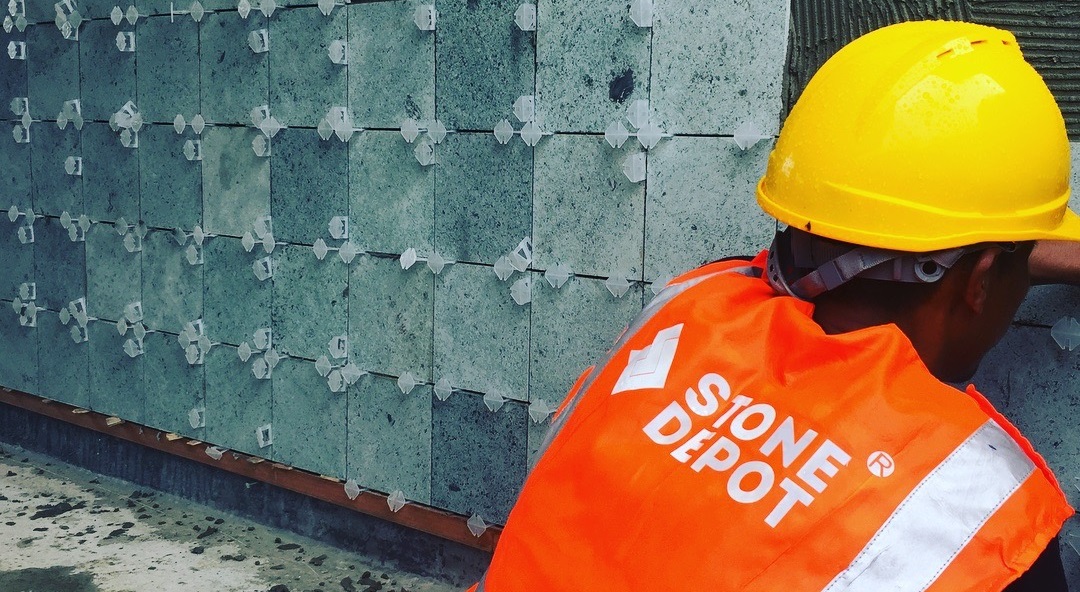
What Is Balinese Swimming Pool Tiles?

The natural stone used to manufacture Balinese swimming pool tiles provides an unmatched sense of beauty and tranquility to any outdoor space. With their unique texture and color, these stones can transform an ordinary swimming pool into a luxurious recreation area reminiscent of the Balinese landscape. Proper care is essential to maintain its beauty and longevity.
In addition to being visually attractive, Balinese rock potatoes require regular care to protect them from inclement weather and daily wear and tear. If these tiles are not properly cared for, they can lose their luster, develop stains, or even suffer structural damage over time. Take the necessary measures to keep your Bali swimming pool tiles looking clean and maintaining their lifespan, so you can enjoy their beauty for years to come, whether through regular cleaning, use of sealant, or regular inspections.
With our help, you will find the best way to keep your Bali swimming pool tiles clean for years to come:
How To Taking Care of Bali Swimming Pool Tiles?
Regular cleaning is an important part of caring for Bali swimming pool tiles. Dirt and leaves can build up on the tile surface over time, causing stains and discoloration. To avoid this, clean the tiles at least once a week. To gently scrub the surface, use a soft-bristled brush and mild detergent. Avoid harsh chemicals as they can damage the smooth natural rock surface.
As Bali swimming pool tiles are porous and can absorb water, potentially causing damage. It is very important to use a high-quality sealant to protect the tiles from moisture. Sealants prevent water from penetrating the stone, reducing the chance of cracking, chipping, and other damage. Reapplying sealant should ideally be every six months to a year; however, depending on pool use and exposure to the elements, these intervals may change.
Algae stick to your Bali pool tiles and cause a slippery surface and unpleasant green stains if left unchecked. Maintaining the balance of chemicals in your pool water is vital to preventing this from happening. Regularly test chlorine levels, pH, and other chemical balances to ensure that they are within recommended ranges. As part of your regular pool maintenance, consider using an algaecide.
Why We Need To Maintaine the Balinese Swimming Pool Tiles?
Regularly checking your Bali pool tiles is critical to identifying potential problems before they become significant problems. Look for signs of wear such as cracks, chipping, or loose tiles. To avoid further damage, spot the problem immediately. In some situations, you may need to keep the surface smooth and safe by replacing damaged tiles or reusing grout.
While regular DIY maintenance is important, at least once a year it is a good idea to hire a professional stone care specialist. A professional can provide a deep cleaning, resealing, and repair that is better than regular maintenance. They will ensure your Bali swimming pool tiles get the best care, extend their life, and maintain their beauty well with their expert help.
Caring for Bali swimming pool tiles to maintain their natural beauty and function is very important. If you follow these suggestions, you can ensure that your outdoor pool remains the center of attention and provides a luxurious and tranquil atmosphere where you can relax and enjoy yourself. Professional maintenance provides an additional level of care that guarantees long-lasting results, but regular cleaning, sealing, and inspections are essential to keeping stone clean. Your Balinese swimming pool tiles will continue to showcase your Balinese style in your home for years to come with proper care and attention.
If you are interested in using Balinese swimming pool tiles of Stone Depot for your Living Space, please contact us by clicking the following Whatsapp link: https://wa.me/6285336906433 (Putri) or email: [email protected].
Siding is a great option to enhance the beauty and durability of your home’s exterior. Balinese stone has a unique combination of natural strength, cultural significance, and aesthetic appeal, which makes it stand out among the variety of materials available. This guide will help you choose the ideal Balinese stone for your walls.
Understanding Types of Balinese Stone
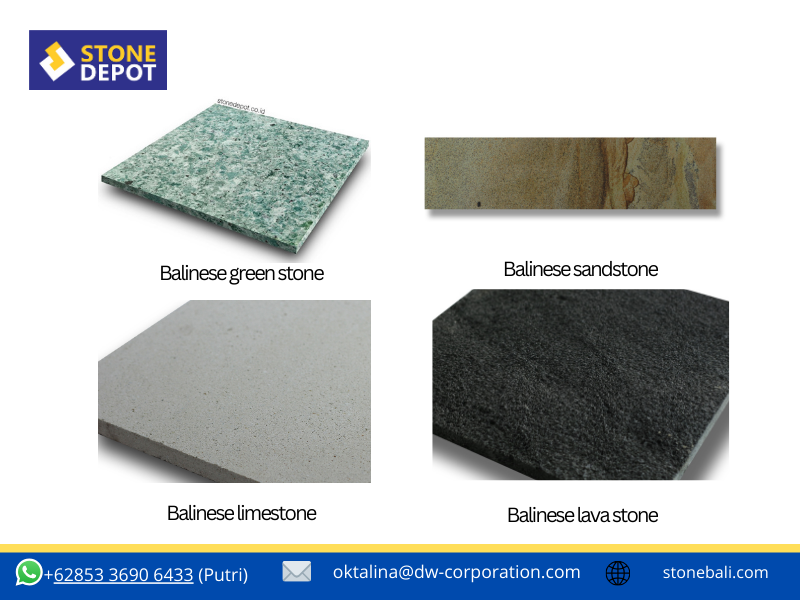
There are many types of Balinese stone, and each has unique characteristics. The most common types include:
1. Balinese Limestone
Balinese limestone is suitable for a calm and elegant look due to its soft texture and light, warm color. It is suitable for both modern and traditional designs.
2. Bali Sandstone
This stone comes in a variety of earthy tones, ranging from warm yellow to creamy white. Its rough, natural surface adds rustic charm to the outside.
3. Bali Lava Stone
Dark, porous Balinese lava stone is highly durable and heat resistant, making it perfect for creating bold and eerie images on your walls.
4. Bali Green Stone
This subtle green stone is very popular in resort and tropical designs. It is known for its cooling properties, which makes it ideal for warm regions.
How To Choose Balinese Stone for Your Design
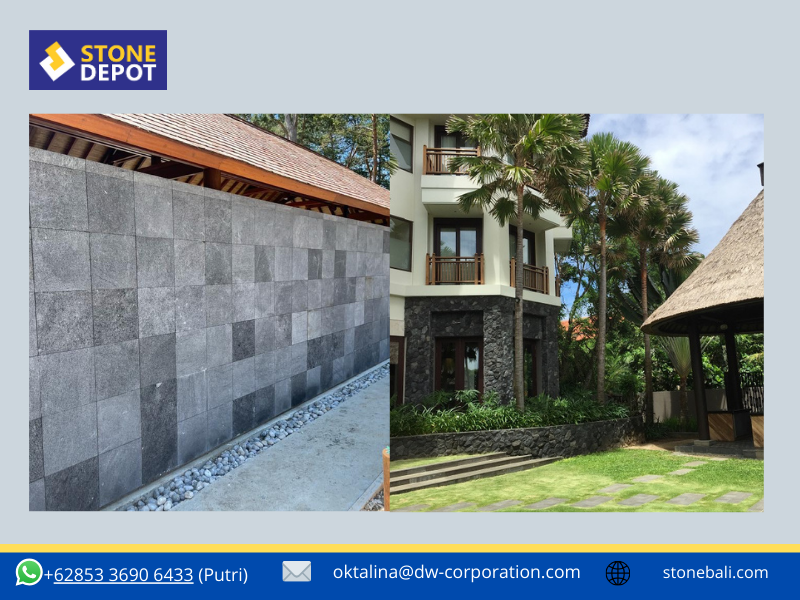
The appearance of the wall covering is very important. The stone you choose must match the design of your home. For example, if you have a modern, minimalist home design, Balinese limestone or sandstone with its clean lines and subtle colors may be the best fit. On the other hand, if you prefer a more rustic or dramatic look, the rough texture of Balinese lava stone or sandstone can add the depth and character you need.
Although Balinese stone is known for its durability, different types require different care. For example, Balinese limestone is softer and may require more frequent sealing to protect it from moisture and stains. However, Bali lava stone is very hard and easy to care for, making it a great choice for homeowners who prefer to go stress-free.
When choosing a stone, consider the climate around you. Balinese lava rock and sand are very strong and resistant to water if you live in a very wet or high rainfall area.
In home design, sustainability is increasingly important. Balinese stone is definitely an environmentally friendly choice. This reduces the carbon footprint because it is sourced directly from nature and is not processed much. However, the environmental impact of transporting the stone to your location must be considered. Choose a provider that prioritizes ethical sourcing and sustainable practices.
The right choice of Balinese stone really depends on your budget. Due to their unique properties and limited availability, Balinese lava rock and limestone may be more expensive, but Balinese sandstone and limestone are usually cheaper. Since some types of stone may require longer lead times if they need to be imported, it is important to ensure that local suppliers are available.
Technical Guides Before Install Balinese Stone
Installing siding requires skill and precision, especially when using natural stone. To get optimal results, it is very important to hire professionals who have experience installing Balinese stone. Problems such as water leaks, stone movement, or uneven surfaces can arise as a result of improper installation, which can reduce the overall aesthetics of your coating.
You should request samples of the stone you are considering before making a final decision. This allows you to see how it looks in various lights and compare it to other materials used outside your home. You should also ask about the origin of the stone, as this can affect its quality and appearance.
Lastly, consider how the stone will age with time. The weather produces a beautiful patina on some stones, adding to their character and appeal. Others may require regular sealing and cleaning to maintain a clean appearance.
Choosing the right Balinese stone for wall cladding is an important decision that can impact the aesthetics and value of your home. Whether you choose elegant Balinese limestone, rustic Balinese sandstone, or Balinese lava stone, you can make the right choice that will enhance the beauty and longevity of your home.
Wether you are interested in using Balinese stone of Stone Depot for your Living Space, please contact us by clicking the following Whatsapp link: https://wa.me/6285336906433 (Putri) or email: [email protected].

